 Model train Scale and TRACK Gauge BASICS
Model train Scale and TRACK Gauge BASICS
This page describes more than
you might want to know about model railway scales and related
topics like track gauge, standards that allow operation of model
trains from various manufacturers, and many other questions
posed to me across a lifetime of model railroading. Scroll down
to see all the topics.
To see the wide variety of scales and track gauges that have
been used for model railways, check out these links:
Much
confusion surrounds model railway scales, the names given to those
scales, and the various track gauges that can be modeled in each
scale. Let's review all the necessary definitions and possibly
some of that confusion can be cleared up here.
"Prototype"
is a word used to mean the original, full size item that is to
be modeled.
"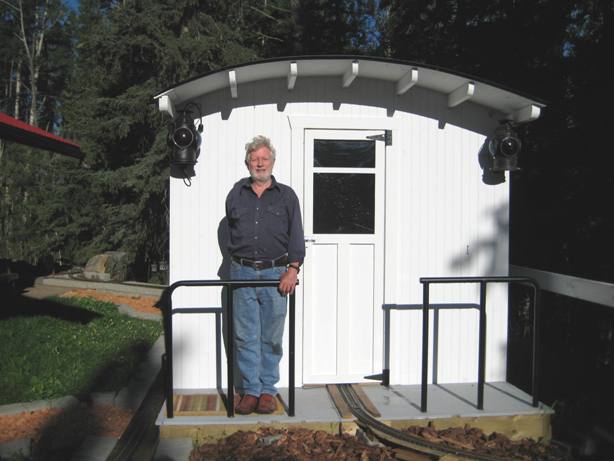 Scale"
or "Scale Ratio" is the ratio in size between an original and a
model of the original. A very popular scale ratio for model trains
and model cars is 1:87, which means that the model's dimensions
are 1/87th the size of the original. This translates to 3.5 millimeters equals
1 foot. The "Scale Name" given to this Scale Ratio is "HO
Scale", each
letter pronounced separately as "aitch-oh". See more
about Scale Names in the Tables below. Scale"
or "Scale Ratio" is the ratio in size between an original and a
model of the original. A very popular scale ratio for model trains
and model cars is 1:87, which means that the model's dimensions
are 1/87th the size of the original. This translates to 3.5 millimeters equals
1 foot. The "Scale Name" given to this Scale Ratio is "HO
Scale", each
letter pronounced separately as "aitch-oh". See more
about Scale Names in the Tables below.
This is my 1:1 scale (full-size)
model
of Denver, South Park and Pacific Railway waycar #60.
It is a model of a prototype that ran back in the 1880's. 
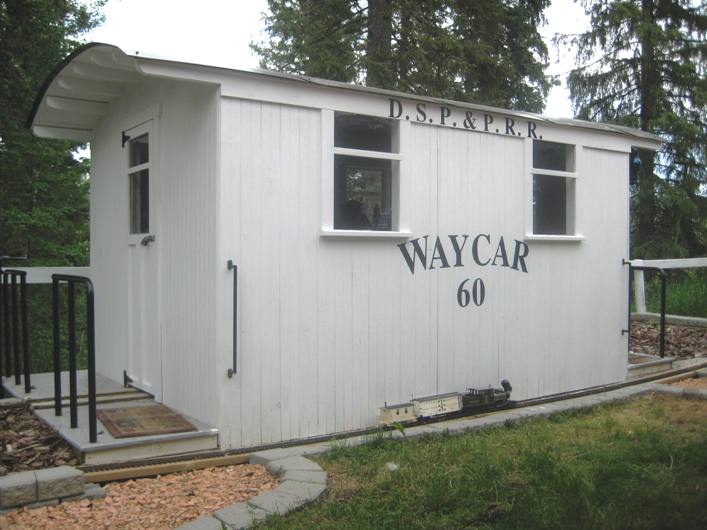
It's hard to image the size of the prototype compared to a model
unless you put them side-by-side. Here's an example.
 My full size caboose with a 1:20 or "F" scale train running
along the bottom edge. The little caboose on the left end of
the short train is 1/20th the size of the full size caboose. An
HO scale train would be about 4.5 times smaller again. My full size caboose with a 1:20 or "F" scale train running
along the bottom edge. The little caboose on the left end of
the short train is 1/20th the size of the full size caboose. An
HO scale train would be about 4.5 times smaller again.
"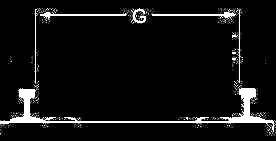 Gauge"
or "Track Gauge" is the distance between the rails of real or
modeled railway tracks. On the illustration at the right, the
Track Gauge "G" is the distance between the inside edges of the
rails. Gauge"
or "Track Gauge" is the distance between the rails of real or
modeled railway tracks. On the illustration at the right, the
Track Gauge "G" is the distance between the inside edges of the
rails.
"Standard Gauge" for North America, Britain, and parts of Europe,
Asia, Africa, and Australia is 4 feet 8-1/2 inches (1435 mm).
This strange dimension may go back to Greek and Roman chariots,
which were designed to fit a standard stone road or bridge. Many
early steam locomotives in Britain were made to the same size.
Note that some European standard gauge is 1440 mm instead of
1435 mm.
Standard
Gauge was adopted by law in the USA in 1886. At that time a census
of railways showed 25 different gauges in use across the country.
Many railways were built, and some still operate, with wider gauges.
One of the widest gauges, 7 feet 1/4 inch (2.14 meters), was used
in the early days in Britain. These are usually called Wide Gauge
or Broad Gauge. Some logging railways, especially those with horses
for dragging logs, used gauges of from 6 to 9 feet.
There are also Narrow Gauge railways, with the gauge less than 4
feet 8-1/2 inches, typically 18, 24, 30, 36, and 42 inch gauge.
In USA, 36 inch gauge was common in the 1880s in mountainous and
mining operations.
Standard Gauge, In HO Scale, would be 1/87th of
4'8.5", or 0.649 inches (16.5 millimeters). The gauge specified is
usually the minimum allowed for safe operation and tolerances
are given to indicate the maximum distance allowed.
"Scale
/ Gauge
Combination" is a track gauge used with a particular model scale.
The same gauge of model track can be used in several scales to
represent different gauges in these various scales. For example,
1-3/4 inch (45 mm) gauge track is used to portray many gauges
in many scales.
"Gauge
Name" is the word or abbreviation used as a shorthand label to
identify a model track gauge. For example, a track gauge of 1-3/4
inches (45mm) is traditionally called Gauge 1, but could be called
Fn3 if it was used to represent 3 foot narrow gauge in F Scale.
There is a phenomenal variety of names used for the same gauge,
depending on what the track is being used for..
A
railway rolling stock model is not fully described unless both Scale and Gauge
are specified. A railroad structure like a station or a water
tank is fully described by its scale only, as there is no track
gauge associated with a building.
Unfortunately, some Scale Names are used to represent
more than one Scale Ratio. For example, O Scale can mean any one
of four scale ratios. This is really confusing, even to experts.
To
make matters difficult, there are more than 60 different scales
in use today for model railways. Not all scales are equally popular,
and some are more popular in Europe or Britain than in North America.
Some are exceedingly rare and never seen except in old magazine
stories.
Even
more confusion comes from mixing the words Scale and Gauge. For
example HO is the name of both a scale (HO Scale) and a gauge
(HO Gauge) of model train track. Some writers use the word Gauge
when they mean Scale, and vice-versa.
A
name like HOn3 is often called a Scale but is, in fact, a Gauge
of track, namely 3 foot Narrow Gauge, modeled in HO Scale. Even the National
Model Railroad Association (NMRA) fails to make the distinction
in their Standard S-1 and related documents.
Manufacturers,
advertising copywriters, and editors have a collective amnesia
about perfectly good names that have been used in the past, and
insist on inventing new names. This is usually done without regard
to any established conventions or naming rules.
Scales
that have small Scale Ratios are called Large Scales (eg. 1:20), because
the models are quite large, and Small Scales have large Scale Ratios
(eg, 1:160). The breakpoint between large and small is usually
above 1:48 scale ratio (anything larger than O Scale)..
The
most common commercially available scales for model trains in
North America are named
Z (1:220 ratio), N (1:160), HO (1:87), S (1:64), O (1:48), and
G (1:22.6+/-) scales. G Scale is only one of seven so-called “Large
Scales” that have scale ratios running between 1:13.5 and
1:32.
The illustration below, showing the head-on view of a modern
diesel, illustrates the relative sizes of these scales. Note that
the illustration on the screen is about one-half actual size.
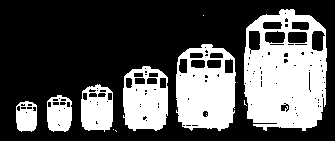
The
HO locomotive shown above would be a little more than 1 inch wide and the
G scale locomotive would be about 4-1/4 inches wide.
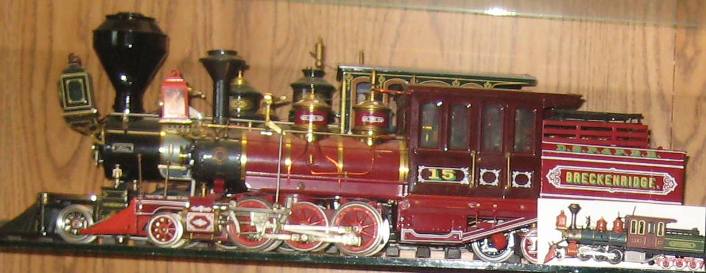
In the background, a 1:20 scale locomotive (22.5 inches long),
in front of it is a 1:24 scale model of the same locomotive (18.75
inches long), and at the bottom right, an HO scale model of the
same locomotive (5.0 inches long), all of them a DSP&P 2-6-6T
Mason Bogie locomotive of the 1880's. These are 3-foot narrow
gauge steamers, so they could be called Fn3, Hn3, and HOn3 gauge
locomotives.
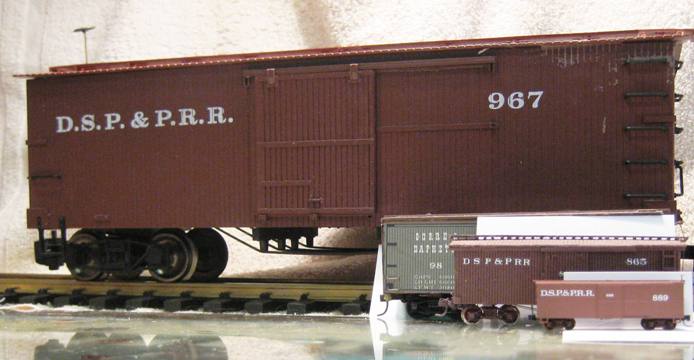
All four of these models are 28 foot 3-foot narrow gauge
boxcars. At the rear is a 1:22.6 "G" Scale model. It can be used
in 1:20 and 1:24 scales and no one would notice the fact that
the car was not exactly 28 feet long. The Gorre and Daphetid car
represents a 1:64 "S" Scale version. In front of that is a 1:87
HO Scale version and a 1:160 "N" scale car. If the G Scale car
was painted for a Standard Gauge railroad, it would represent a
36 foot old-time boxcar in 1:32 "1" Scale. The G&D boxcar is
actually a 36 foot HO standard gauge car, "standing-in" as an S
Scale narrow gauge car for this photo.
 MIXING
SCALES and GAUGES MIXING
SCALES and GAUGES
This can be used in model railroading for several
reasons. A mix of standard and narrow gauges using a common
scale is the usual situation. It mimics real life railroad
scenes where two railways of different gauges meet and
interchange shipments. It can lead to Dual Gauge Track,
which can be complicated and interesting to viewers and
operators of the model trains.
Using a much smaller scale for track, trains, and buildings can
simulate an amusement park ride for children and adults. I used
an N Scale train on my indoor G Scale railway for this purpose.
A real life garden railway built at 1:20 scale could use a Z
Scale model train to represent a garden railway in the back yard
of a model home.
Finally, using the next smaller scale on trains running in the
background can be used to enhance the sense of distance by
tricking the eye with forced perspective. I did this by using an
O Scale train on a "distant" mountain on my G scale layout. You
can translate these concepts easily to smaller scale model
railways in HO, S, and O Scales. Smaller scale buildings,
vehicles, and trees in the background can be used in the same
way to expand the horizon.
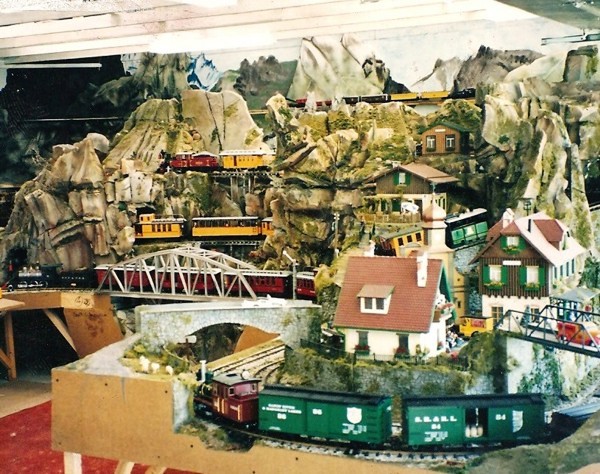
The yellow train in the upper background is O Scale (1:48) while
the yellow train in the middle foreground is G Scale (1:22.5).
The two trains are only 12 feet apart, but the sense of distance
is much larger.
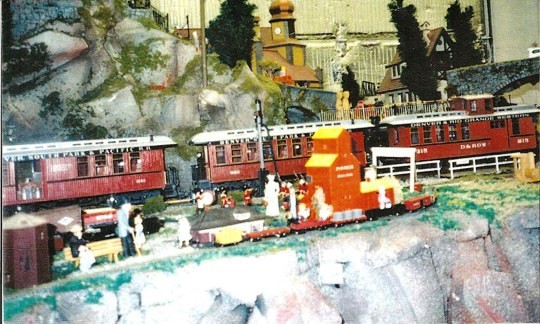
A 1:22.6 Scale passenger train pauses at Tiny Town to drop off children
to ride on the 1/8 scale
"live-steam" train (N Scale) that circles the 1/8 scale grain elevator and
station.
Mixing rolling stock from different Scales in the same train
can look strange when the sizes are too different. This
happens most often in the large scale environment where 1:32 and
1:29 Scale standard gauge trains can run on the same physical
track as 1:20 or 1:22.5 Scale narrow gauge trains. When an
old-time steam engine is physically bigger than a modern diesel,
the sense of realism is broken.
 SCALING
DIMENSIONS, WEIGHT, and SPEED SCALING
DIMENSIONS, WEIGHT, and SPEED
Scale Length is shorter than prototype length by a factor equal to the
Scale Ratio. The equation is:
Scale length (inches) = Prototype length (feet) times 12
inches/foot divided by Scale
Ratio
For example: a 40 foot boxcar in O scale would be 40 feet times 12
inches/foot / 48 = 10 inches.
Scale track gauge (inches) = Prototype track gauge (inches) divided
by Scale Ratio
For example: standard gauge track (56.5 inches) in O scale would be
56.5 inches / 48 = 1.77 inches.
Scale track gauge (millimeters) = Prototype track gauge (mm) divided
by Scale Ratio
For example: standard gauge track (56.5 inches) in HO scale would
be 56.5 inches times 25.4 mm/inch / 87 = 16.5 mm.
Scale
Area is smaller by a factor equal to the Scale Ratio squared,
and Scale Volume decreases by a factor of the Scale Ratio cubed.
Thus
a mile of track at a scale of 1:87 is 5280 feet divided by 87,
which equals 60.68 feet. A scale square mile of land would be
about 61 by 61 feet, which is much larger than most model railways.
That's why we use Selective Compression to pack a meaningful scene
into a small space on a model. For example, a typical paved 2-lane
highway is 100 feet wide between fence lines. This is 13-3/4 inches
wide in HO Scale. We can't afford to give up over a foot of space
for a highway on a model, so we selectively compress it to less
than 6 inches. The eye usually doesn't mind.
Scale
Weight is proportional to volume, so the weight of a 100 ton locomotive,
at 1:87 scale, would be: (100 tons x 2000 lb/ton x 16 oz/lb) divided
by (87 x 87 x 87) = 4.86 ounces. This would be far too light to
operate; the average model locomotive at this scale weighs 10 to
20 ounces. Unfortunately, we can't model the pull of gravity.
Scale
Speed equals actual speed multiplied by the Scale Ratio. A model
traveling 20 feet per minute is moving at an actual speed of 0.227
miles per hour, equivalent to almost 20 scale miles per hour in
HO Scale (1:87). Most models travel too fast; the worst being
run at over 300 scale miles per hour. The conversion equation
is:
Scale Speed (mph) = 1/88 times Speed (feet/minute) times Scale
Ratio
Many
people use a Scale Mile (often called a Smile) which is shorter
than a real scale mile, and others use Scale Tine, usually 5 to
10 times faster than real time, to account for selective compression
of model railways and the high speeds of model trains. Here, Scale
speed (sph) = Smiles divided by Scale time.
 CONVERSION
FACTORS CONVERSION
FACTORS
1
inch = 25.4 mm exactly |
1
meter = 3.281 feet exactly |
Ratio
= 12 / (inches/foot) |
inches/foot
= 12 / Ratio |
Ratio
= 12 / (mm/foot) / 25.4 |
mm/foot
= 12 * 25.4 / Ratio |
Ratio
= 1000 / (mm/meter) |
mm/meter
= 1000 / Ratio |
Model
track gauge (inches) = Prototype gauge (inches) / Ratio
|
Model
track gauge (mm) = 25.4 * Prototype (inches) / Ratio |
%
Error To Prototype = ((Model track gauge * Ratio / Prototype
gauge) - 1) * 100 |
(+)
= model tracks are too wide, |
(-)
= model tracks too narrow. |
 MODEL
TRAIN Standards
- Scale
and Gauge MODEL
TRAIN Standards
- Scale
and Gauge
The
National Model Railroad Association (NMRA) has established wheel
and track standards or recommended practices for some scale and
gauge combinations used in North America. Similar organizations
in Britain and Europe have also set standards (MOROP and NEMA),
some of which conflict with NMRA standards. Some small, and not
so small, special interest groups (SIGs) have also set their own
standards to permit equipment interchange between modelers who
follow these, often more rigorous, standards. You may find minor
incompatibility in wheels and track from different countries or
different manufacturers.
 MODEL
RAILWAY STANDARDS IN NORTH AMERICA MODEL
RAILWAY STANDARDS IN NORTH AMERICA
The
purpose of standards, of course, is to assist in creating at least
some minimum compatibility between models, of nominally the same
scale, made by different manufacturers. Unfortunately, standardization
has not been achieved in any of the larger scales, and has been
fragmented in the smaller scales, by separating fine scale and
high rail standards from normal and coarse scale standards.
There
are at least 60 scales in use today; the most common 10 basic
scales used to represent Standard Gauge railways in North
American are listed below. The track gauge dimensions and many
other detail standards for these scales have been published by NMRA, the first attempts dating from 1936.
|
Scale
Name |
Model
Track Gauge inches |
mm |
Scale
Ratio 1:xxx |
Relative
size To Next Scale |
Relative
Size To Next Gauge |
Gauge
Name |
|
1.
Z Scale |
0.257 |
6.53 |
220 |
0.727 |
0.728 |
Z |
|
2.
N Scale |
0.353 |
8.97 |
160 |
0.75 |
0.749 |
N |
|
3. TT Scale |
0.471 |
12 |
120 |
0.726 |
0.726 |
TT |
|
4.
HO Scale |
0.649 |
16.5 |
87.1 |
0.735 |
0.742 |
HO |
|
5.
S Scale |
0.875 |
22.2 |
64 |
0.75 |
0.7 |
S |
|
6.
O Scale |
1.25 |
31.8 |
48 |
0.667 |
0.708 |
O |
|
7.
3/8" Scale |
1.766 |
44.9 |
32 |
0.75 |
0.706 |
Ga.
1 |
|
8.
1/2" Scale |
2.5 |
63.5 |
24 |
0.667 |
0.714 |
Ga.
3 |
|
9.
3/4" Scale |
3.5 |
88.9 |
16 |
0.75 |
0.737 |
Ga.
4 |
|
10. 1"
Scale |
4.75 |
121 |
12 |
---- |
---- |
7.5
inch |
Note
that most scales are approximately 3/4, or 0.75, times the next
scale in the list. I call this happy coincidence "CRAIN'S 3/4 RULE".
The
3/4 RULE makes it easy to use track and wheel sets from a smaller
scale as narrow gauge components in a larger scale, because 3
foot and meter gauge railway equipment is usually constructed
to be about 3/4 the size of standard gauge equipment. For example,
the average older standard gauge boxcar is 10 feet wide and 40
feet long. Many 3 foot gauge boxcars are 7 to 8 feet wide and
28 to 30 feet long.
In
the USA, the NMRA has traditionally recognized three additional
scales, namely OO Scale (1:76.2), O17 Scale (1:45.2), and G Scale
(1:22.5). These scales are close to HO, O, and 1/2" respectively.
Recently, NMRA proposed some additional scales as standards.
The additions to the NMRA list are 1-1/2 inch Scale (1:8), M Scale
(1:13.5), F Scale (1:20.3), and A Scale (1:29). They represent
the latest trends in Large Scale modeling practice but sadly,
they were never
adopted as standards, which demonstrates a serious lack of
respect for Large Scale members, and has driven most practitioners
to other Associations (GMRA.org and others).
 MODEL
RAILWAY STANDARDS IN BRITAIN AND EUROPE MODEL
RAILWAY STANDARDS IN BRITAIN AND EUROPE
In
Britain and Europe, additional standard scales are defined by MOROP and NEMA.
|
Scale
Name |
Model
Track Gauge |
|
Relative
Size |
Comparable
North American |
| |
inches |
mm |
Scale
Ratio 1:xxx |
To |
Next |
Scale |
Ratio |
|
1.
2 mm Scale |
0.371 |
9.42 |
152 |
0.67 |
0.79 |
N |
160 |
|
2.
3 mm Scale |
0.472 |
12.00 |
102 |
0.75 |
0.63 |
TT |
120 |
|
3.
4 mm Scale |
0.750 |
19.10 |
76.2 |
0.57 |
0.60 |
OO |
76.2 |
|
4.
7 mm Scale |
1.250 |
31.80 |
43.5 |
0.70 |
0.71 |
O |
48 |
|
5.
10 mm Scale |
1.766 |
44.90 |
30.5 |
0.71 |
0.71 |
3/8" |
32 |
|
6.
14 mm Scale |
2.500 |
63.50 |
21.7 |
0.88 |
0.71 |
G |
22.6 |
|
7.
16 mm Scale |
3.500 |
88.90 |
19.1 |
---- |
---- |
3/5" |
20 |
Most
of these are considered fine scales, but normal or coarse scale
versions also exist. The 3/4 RULE is not as neat for continental
scales. Some North American scales. such as Z, N, HO, O, and G
Scales, are also common in Britain and Europe, as are a number
of lesser used scales not listed above.
 MODEL
RAILWAY STANDARDS FOR NARROW GAUGE MODELS MODEL
RAILWAY STANDARDS FOR NARROW GAUGE MODELS
In
mountainous regions, and on construction or mine sites, standard
gauge was too expensive or the equipment was too large to be
practical, so NARROW GAUGE railways were built,
often 24, 30. 36 or 42 inches (or equivalent metric gauges).
narrow gauge sTANDARDS
exist for some scales. Names of these scale/gauge combinations
vary between Europe and North America. In Europe, a lower case
letter is appended to the generally accepted scale name, for
example HOm, where the "m" stands for meter gauge. The other
letters used are "e" for 800+/- mm gauge (30"+/-), "i" for
industrial 650+/- mm gauge (24"+/-), "f" for field railways 450
mm+/- gauge (15 to 18"), and "p" for park trains 300+/-mm gauge
(12"+/-). Hence scale/gauge names like HOe, Gm, and Of can be
found in advertisements for commercially available models. Just
which actual gauge track is required is not usually specified.
In North America, the descriptions use the scale name, followed
by a lower case "n", and a number. A single digit number
represents the gauge in feet, a two digit number represents the
gauge in inches, for example On3, Sn3, HOn3, or Nn3, (3 foot
gauge) and HOn30 or On30 (30 inch gauge). Stranger combinations
such as Gn15 and HOm can be found, as well as HOn2-1/2 (for
HOn30).
Crain's Scale/Gauge Encyclopedia tables will show you which
track gauge to use to represent these various combinations.
The narrow gauge names and scales for which NMRA provides
standards are shown in this table.
| |
|
Track
Gauge |
|
| |
Gauge
Name |
inches |
mm |
Scale
Ratio 1:xxxx |
| |
|
|
|
|
|
1 |
Nn3 |
0.250 |
6.35 |
160 |
|
2 |
HOn3 |
0.413 |
10.50 |
87.1 |
|
3 |
HOn2 |
0.276 |
7.01 |
87.1 |
|
4 |
Sn3 |
0.563 |
14.30 |
64 |
|
5 |
On3 |
0.750 |
19.10 |
48 |
|
6 |
On2 |
0.500 |
12.70 |
48 |
NMRA has proposed adding the following standards but have not
followed through.
|
7 |
Mn2 |
1.772 |
45.0 |
13.5 |
|
8 |
Fm |
1.949 |
49.5 |
20.3 |
|
9 |
Fn3 |
1.772 |
45.0 |
20.3 |
|
10 |
Fn30 |
1.476 |
37.5 |
20.3 |
|
11 |
Fn2 |
1.181 |
30.0 |
20.3 |
|
12 |
Gm |
1.772 |
45.0 |
22.5 |
|
13 |
Gn3 |
1.614 |
41.0 |
22.5 |
|
14 |
Gn30 |
1.259 |
32.0 |
22.5 |
|
15 |
An42 |
1.476 |
37.5 |
29 |
|
16 |
An3 |
1.259 |
32.0 |
29 |
|
17 |
An2 |
0.886 |
22.5 |
29 |
|
18 |
#1m |
1.259 |
|
32 |
|
19 |
#1n3 |
1.126 |
|
32 |
|
20 |
#1n2 |
0.752 |
|
32 |
|
21 |
TTn3 |
0.300 |
|
120 |
Whether
any or all of these proposals are adopted or modified, only time
will tell.
NMRA
Standard S-1 and other NMRA documents incorrectly refer to these
narrow gauge names as SCALES, instead of GAUGES. Additional standards
are specified in NMRA Recommended Practices for fine scale and
high rail versions of some gauges.
In
the tables, track gauge dimensions are given in inches
and millimeters. Where two dimensions are given, these are the
minimum and maximum dimensions given in NMRA Standards or Recommended
Practices (either official or proposed). Where a single value
is shown, a non-NMRA source was used.
To see the wide variety of
scales and track gauges that have been used for model railways,
check out these links:
|

 Gauge"
or "Track Gauge" is the distance between the rails of real or
modeled railway tracks. On the illustration at the right, the
Track Gauge "G" is the distance between the inside edges of the
rails.
Gauge"
or "Track Gauge" is the distance between the rails of real or
modeled railway tracks. On the illustration at the right, the
Track Gauge "G" is the distance between the inside edges of the
rails. 

